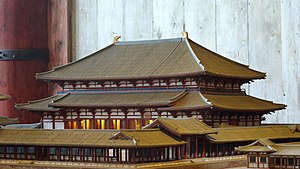| Siege of Nara | |||||||
|---|---|---|---|---|---|---|---|
| Part of the Genpei War | |||||||
 A model of the Great Buddha Hall of Tōdai-ji that was burnt down in this siege (Founded in the 8th century) | |||||||
| |||||||
| Belligerents | |||||||
| Taira clan | Warrior monks of various Nara temples | ||||||
| Commanders and leaders | |||||||
| Ygaku | |||||||
| Strength | |||||||
| 7,000 monks | ||||||
| Casualties and losses | |||||||
| Unknown | 3,500 civilians, and 1,000 warrior monks | ||||||
| Genpei War | |
|---|---|
The Siege of Nara (南都焼討, Nantō Yakiuchi) alternatively known as the Nanto Arson Campaign in Japan is an event which took place on January 15th 1181 (December 28th 1180 in the Jishō calendar), following Prince Mochihito and Minamoto no Yorimasa defeat and subsequent death to the Taira clan, after which the Taira forces burnt down the Miidera temple (which had sheltered the anti-Taira forces), before moving on to Nara, where they "set fire to the monastic complexes of Kōfuku-ji and Tōdai-ji."
Background
In June, after the suppression of Mochihito's army, the Taira clan punished Mii-dera Temple, which had been involved in the rebellion, by prohibiting it from participating in court sessions, dismissing its priests, and confiscating the temple's territory. Kōfuku-ji (one of the powerful Seven Great Temples in Nara) was not punished as severely as Mii-dera. At the end of the year, the people of Mii-dera and Kofuku-ji joined the uprising of the Ōmi Minamoto clan and others in the Omi Campaign [ja], which finally led the Taira to turn the tables on Kofuku-ji when Taira Shigehira attacked and burned down Mii-dera.
Nara was regarded as a rebel against the throne because it had sided with Miidera and received Prince Takakura when he led the revolt. Once the temples at Nara had heard of this, they rose up like "a swarm of angry bees".
Battle
Taira no Kiyomori first sent Seone Kaneyasu [ja] with 500 soldiers to Nara. Kiyomori instructed Kanayasu to settle the matter in as peaceful a manner as possible and sent him off lightly armed. However, the monks of Nara captured and beheaded over 60 of Kaneyasu's men and lined them up at the edge of Sarusawa Pond, causing Kanayasu to return to Kiyomori. A now infuriated Kiyomori sent Taira no Shigehira and Tomomori, both sons of Kiyomori, to siege Nara with "about 40,000 horsemen" (However, the The Tale of the Heike is known for exaggerating numbers).
The monks, numbering around 7,000 men, began digging ditches in the roads, and built many forms of improvised defenses. They fought primarily with bow & arrow, and naginata, while the Taira were on horseback, giving them a great advantage.
Soon the Taira forces arrived, after which they divided into two, attacking the two defensive positions the monks had built. By nightfall, both positions had been broken through. Despite the monks' strategic defenses, their enemy succeeded in defeating even the best monks of Nara, and Shigehara ordered nearly every temple in the city to be lit, and the fire spread quickly due to the winds at the time. Soon the elderly and young (numbering roughly 1,000) began to flee into the Great Buddha Hall of the Tōdai-ji [ja], but soon it was destroyed by fire too, with the Kofuku-ji falling aswell. Only the Shōsōin survived.

The Heike Monogatari laments the destruction of the Tōdai-ji's Daibutsu (Great Buddha statue) and Nara:
The colossal statue of Vairocana Buddha of copper and gold, whose domed head towered up into the clouds, from which gleamed the sacred jewel of his lofty forehead, fused with the heat, so that its fullmoon features fell to the pavement below, while its body melted into a shapeless mass. The myriad beauties of his Buddha Presence were hidden in the smoke like the autumn moon among the clouds . The whole sky was filled with smoke, and the flames roared upward continually.
Aftermath
In all, 3,500 non-combants died in the burning of Nara, with another 1,000 warrior monks, some of whose heads where hung on the gates of the Hannya-ji, while some were carried back to Kyoto. Kiyomori alone was greatly rejoiced at the news, while the Empress, and the Retired Emperor all sorrowed at the destruction of so many temples, though somewhat pleased that the rebellious monks of Nara were exterminated. The courtiers had decided that the heads of the monks should be displayed on public scaffolds as punishment. However, they did not go through with any decisions regarding the tragic destruction of the Nara temples. In the writings of the Emperor Shōmu it says:
"When my temple of Kofukuji is prosperous the whole Empire shall be prosperous, and when my temple falls to ruin the Empire will decline also"
Due to this, many now believed the fall of the Empire was inevitable.
References
- ^ Turnbull, Stephen (1977). The Samurai, A Military History. MacMillan Publishing Co., Inc. pp. 47–50. ISBN 0026205408.
- Turnbull, Stephen (1998). The Samurai Sourcebook. Cassell & Co. p. 200. ISBN 1854095234.
- Sansom, George (1958). A History of Japan to 1334. Stanford University Press. p. 315. ISBN 0804705232.
- "THE BURNING OF MIIDERA". Heike Monogatari. p. 209.
- ^ "THE BURNING OF NARA.". Heike Monogatari. p. 257.
- Turnbull, Stephen (2003). 'Japanese Warrior Monks AD 949-1603'. Oxford: Osprey Publishing.
34°41′00″N 135°48′00″E / 34.683333°N 135.8°E / 34.683333; 135.8
Categories: